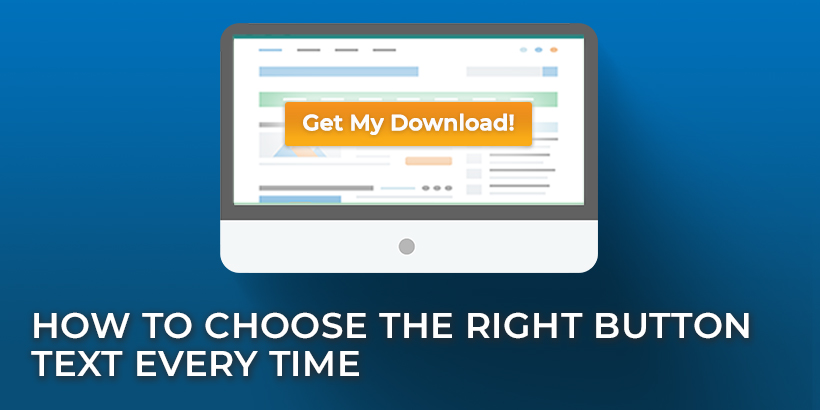
Some marketers don’t put much thought into button text. Over time, most organizations wind up with a handful of buttons they use for everything. It’s convenient, but not strategic.
Your button text is one of the most critical pieces of your call-to-action. It tells people what will happen if they click through your ad, email, or landing page. So it has a big impact on whether or not they do.
Here are four tips for choosing the best button text for every asset you create.
1. Make it clear
Button text can make or break your click-through rate. Whether you’ve built up to that button text with 1,000 words, or 10, this is the moment where people decide what to do next. And if your button text is unclear, it may as well say “Leave” or “Ignore,” because that’s what your audience will do with your email, ad, or landing page.
Take a look at the button text on this ad, and imagine encountering it on a website:

Image source: https://www.wordstream.com/blog/ws/2015/02/20/call-to-action-buttons
The conference pass on the left is the only solid indicator that this is an ad for a conference, and the context leads you to believe you’re supposed to buy a ticket . . . but the text says “strike” now.
Someone was trying to be clever and create urgency. But “strike” is an ambiguous verb, and it’s also a noun with multiple meanings. When you only have someone’s attention for a few seconds, you can’t afford to waste a single moment with confusing directions.
Imagine that you’re taking a bus somewhere, but right before you step on the bus you realize you’re not sure where it’s headed. That’s what it feels like when a button doesn’t tell you where you’re about to go. And there’s no bus driver to explain it to you. So unless you’re comfortable with not knowing where you’re going, you’re not going to click.
Your button text should work with the rest of the copy and design to clearly communicate what your audience is supposed to do next, and what happens when they click.
You don’t need to reinvent the button. In fact, the more you deviate from what people expect to see in a button, the more you risk someone not understanding what it does. That’s not to say you can’t experiment or try new things. Just keep it simple.
2. Don’t make assumptions
There are a lot of theories when it comes to buttons. Is first person language (me/my) better, or second person language (you/your)? Should the text be a whole sentence, a phrase, or just one or two words? Are green or orange buttons better?
The reality is, there are very few universal rules, and you can’t know for sure what will work best until you A/B test it. A single case study about a single instance where one type of button text worked better has little bearing on what will work well in your situation.
Even if you have a great theory about button text, if you don’t test it, your choices basically amount to personal preferences. This is something you should test constantly, because as the context changes, the text that performs best likely will, too.
3. Provide the right supporting text
One of the nice things about buttons: they don’t have to do all the work of getting someone to take your desired action. In an ad, you don’t have as much copy to play with as you do in a landing page or an email, but the text that comes immediately before the button is what contextualizes it for your audience.
You might only need a simple phrase or sentence to lead into your button, like “Find the plan that’s right for you” or “See what we can do for you.” Other times you might need a whole paragraph to transition from the rest of the piece into your call to action.
The point is that your button doesn’t exist in a bubble, and the surrounding copy can do a lot of the work of communicating what the button will do, so that you can keep it clear and simple.
With the right context, one or two-word buttons like “Go” or “Shop now” are all you really need. In other cases, your button text can play off the surrounding copy. In the example above, the button text is attempting to reinforce the urgency created by “ticket prices going up this week,” but it’s a little unclear. This ad could have said something like “Get the lowest price” or “Get the early-bird special” to clearly emphasize the benefit of clicking the button (which is presumably getting tickets for cheap).
4. Try to be consistent
As you test button-text variations, odds are you’re going to find a few options that perform similarly. You might find that changing the length or switching from first to second person doesn’t make much difference. That’s when it’s time to establish norms for your organization (norms which you will continue to test periodically).
Norms keep your brand voice consistent and help frame your audience’s expectations. You don’t see too many variations of street signs, and that’s because it’s important for people to quickly recognize what they’re supposed to do. Your buttons serve as your brand’s street signs. Over time, your audience learns how to quickly recognize what you’re directing them to do and where your buttons will take them.
So test all your button theories, then establish standards. (And keep testing them.)